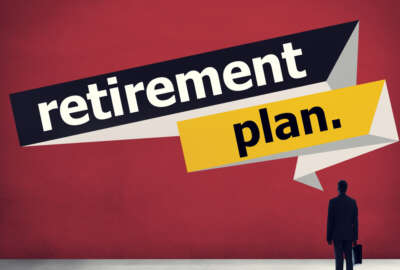Hubbard Radio Washington DC, LLC. All rights reserved. This website is not intended for users located within the European Economic Area.
Retirement planning enters era of renewed inflation
With the era of near-zero inflation over, retirement planning has taken on new urgency, because a fixed income and rising prices don't make a good combination.
With the era of near-zero inflation over, retirement planning has taken on some new urgency, simply because a fixed income and rising prices do not make a good combination. For some of the latest think on all that, the Federal Drive with Tom Temin spoke with Thiago Glieger, with RMG Advisors of Rockville, Maryland.
Interview Transcript:
Tom Temin And you’ve got a lot of good advice for retirement planning at the season when people start to think about the end of the year, and this is when you start putting in papers and so forth. And inflation, though, can really be something. I think people have forgotten about how corrosive it can be.
Thiago Glieger They certainly have. Tom, I loosely call inflation the silent retirement killer. Because for a very long time we’ve not really had inflation like we have, here very recently. And when people think about risk, they often just think about volatility. So, investments in the TSP like the CSI funds but if you think about not growing your money fast enough, that’s also a pretty big risk. So having too much money inside the G fund, especially as you enter retirement, makes sense because you want to protect your wealth. But if you stay in the G fund, that could mean over time you may not be able to keep up with your spending. Imagine having to pay for things today, but with a salary from ten years ago, it would be very difficult to keep up and the concept is pretty much the same.
Tom Temin You would either have to trim your spending or figure out a new investment strategy, and I guess then you might be saying that don’t be overly conservative even though you are retired, you don’t want to bet in Bitcoin and futures and commodities, but maybe you should be a little more aggressive in the funds you pick.
Thiago Glieger Yeah, especially retiring feds who tend to be a little bit more conservative. You have to be prepared for an environment where you’re going to need to be growing your money fast enough to both outpace inflation, as well as replacing some of the spending that you’re doing. Because if you look at 10 or 15 years down the line, you may not be able to have the same kind of spending power if you’re just not keeping up because you’re in things like the G fund for the next decade.
Tom Temin Yeah. And if you look at things like automobiles or replacement roofing and other capital, so to speak, expenditures on your home if you are in your home, these things have gone well, no pun intended, through the roof.
Thiago Glieger They really have. The cost of material has gone up, the cost of labor has gone up, and people generally just spending money on things that they do most, which is food, travel in their home expenditures. Those are the things in which people are really seeing those price increases and struggling to be able to keep up.
Tom Temin And that gets to the topic of being realistic, simply about how much it’s going to cost you to live in retirement.
Thiago Glieger That’s right. I think that a lot of people just think about replacing their income. But really, that might not be all that you need. You know, the first thing is you always have to be thinking about, well, when are you going to file for Social Security? You’re potentially going to have a FERS pension that’s going to kick in at some point. And with those two, the third leg of the three-legged stool, as it’s commonly known, is your portfolio. So, then you start to determine how much do you need to take from your portfolio. But often I suggest to people be thinking about a higher degree of spending, especially in an early retirement. You know, Tom, you were telling me, last time we talked about that amazing trip that you went on recently, and that’s the kind of thing that people want maybe 2 or 3 times a year, while they still have their health and their energy. There’s more travel, there’s more experiences, more spending. You know, maybe you have grandkids at that point. And you start to see a whole lot of one-off expenses that creep up that you need to start beginning to plan for.
Tom Temin Right. So therefore, then the required minimum distributions from that third leg, if that’s all you can do and you’re worried about that, that gets back to the idea of being a little bit more aggressive. So maybe you could take more than the RMD. Confident that the principal will keep growing more than you’ve taken out as your withdrawal.
Thiago Glieger Right. Especially with RMDs where there’s a minimum amount that you have to take out. And so, you’re accelerating these distributions. And at some point you may want to be considering being a little more aggressive.
Tom Temin And how do you plan on what your withdrawals should be. Just simply whatever’s not covered by your FERS pension and Social Security.
Thiago Glieger I think that’s one way to start, you know, is really getting a base for what are your needs? But also, retirement is a time. We call them the golden years. Right? It’s a time where you really want to enjoy your time doing things, and you want to have these experiences that maybe you’ve been putting off for a while. In fact, with our clients, we call the first several years of retirement, maybe 5 or 10 years. We call that the Gogo phase. And that’s when you have the most time that you’ve had the most money you’ve ever had, and you still have a whole lot of energy. And so, thinking about how do I want to design these years? What kind of memories do I want to create? Is it more travel? Is it more this? Is it helping the grandkids? And that will begin to help you understand what kind of cash flow you’re going to need. Then you think you factor in Social Security and FERS and figure out how much more you need to draw from your portfolio.
Tom Temin Right. So that presupposes, at least for that first 5 or 10 years, when you have the intersection of some wealth you’ve accumulated and you’re still able because you won’t be able to forever. Nobody is. Even though the guy peddling pills on cable TV that’s 90, you know, and bench lifts 500 pounds. That’s not really what most people are going into. Then you need to plan for higher spending, perhaps, than you have been just commuting to the drudgery of your cubicle or your dining room.
Thiago Glieger Exactly. And that’s where it becomes really important to begin to finalize and implement that, initial short-term bucket of your portfolio. So, this is the part of your portfolio that’s going to have to be the most conservative, because it’s going to be the one that’s supporting you when you first retire. You know, the problem in investing in stocks is that they tend to be very volatile. And if you are close to retirement or you’re starting to use your money, then you really have to be cautious about how much you’re investing in stocks. The closer you are to using that capital, the more diversification you’re going to need in your portfolio. And one of those buckets is your short-term bucket. I often use the example of when you visit a doctor and the doctor says, Tom, we’re going to need to prescribe this medication for you to take. How much of it do you want to take? Your answer is, obviously, I don’t know as little as possible. Right. The medicine often comes with side effects, and investing for growth is very similar. Having too much in the form of growth investments can actually begin to hurt you in the long run because of that side effect of volatility and other risks that it introduces.
Tom Temin And there’s also tax planning, which can get complicated.
Thiago Glieger That’s right. Taxes are a huge part of every decision in retirement because when you’ve been working you don’t really have very much control over your taxes. You get a W-2 salary and maybe you’ve got some investment income and perhaps some rental properties, things like that. But in retirement, you’re the one that’s designing your income. And so, you get to pick which accounts the money comes from. You get to pick when you take those distributions. And if you think about what your cumulative lifetime tax liability is going to be, where you can estimate what that will be. It’s to the tune of several hundred thousand. Sometimes for some clients, it’s millions of dollars in estimated taxes throughout their whole retirement. And anything you can do to begin to keep some more of that capital for yourself is more living and more spending that you get to do yourself.
Tom Temin And you mentioned the go phase of retirement. What are the phases past that or should I ask?
Thiago Glieger Yeah. After you go through your go phase, we call the next phase the slow go phase. This is where life tends to slow down a little bit. You’re still active, but life has settled into retirement. And maybe your kids and grandkids are a little bit older now, so your priorities will begin to change. Maybe you’re spending more time with the kids rather than traveling. And then beyond that, once you hit the later stages of life, we call that the no go years. So, you have the go, the slow go and the no go and the no go years. You’re really focusing more on your health and taking care of yourself, maybe spending more time with family. And so, the expenses that tend to go for lifestyle are now maybe going towards medical.
Tom Temin And you may have disposed of your house by that point and living in a lower cost situation. Although some of the assisted living and independent living places, they are not low rent.
Thiago Glieger That’s right, many of those are very expensive and despite the cost, I think people are just generally looking for less maintenance. At that point, they may not be able to upkeep with the size of their house or all of the things that are required. So, either they downsize to something more manageable, or they actually move into a place that has some assistance for them to be able to live.
Tom Temin All right. So, you mentioned the go, the slow go and the no go. I guess beyond that is the undergo. No, I mean, it doesn’t matter at all anymore in some sense. Right. What are some good practical ways that if you’re still working to actually do this, start with a budget. Is that what everybody says? Or I mean, what should you be doing to plan for it because you don’t really know when the go will morph into the slow go.
Thiago Glieger Right? I think if you are still working and you are, at least 5 to 7 years from retirement, your priority at that time is still continuing to grow your wealth. And so, utilizing the TSP choices like the C, S and I funds, make sure you’re doing at least the agency maxing, matching contributions amount. If you can match your TSP. Absolutely put more into that every time you’re getting a raise. If you’re not yet maxed, split that raise in half and put half of it as a TSP contribution. And beyond there, as you begin to phase to retirement, that’s when you can start to be thinking about the more. Conservative portions of your portfolio, maybe start diversifying a little bit less. Maybe start taking some risk off the table. Because if you think about how long it takes for a bear market from what we call peak to trough, so that’s from the top to the bottom and back up again, it’s somewhere on average about two and a half years. And so, we tell people to really be thinking about twice that long. So about five years’ worth of a short-term bucket. If you know you’re coming up to that phase of life, that gives you enough time to be able to ride out some of that market volatility, if you’re going to use that money in the very short term, and the bottom falls out.
Tom Temin And right now at this as we speak, we seem to be in a peak. I think the Dow headed toward 40,000, although that’s a really terrible indicator because the Dow has almost no relation to anyone’s actual portfolio, does it?
Thiago Glieger That’s right. The Dow represents a market index, and most people are not invested 100% in the Dow. Same thing with the S&P 500 right. The TSP fund the fund. Those are representative of some of those market indices. But you’re really not 100% invested in that actual index.
Tom Temin And you can probably make yourself prematurely crazy if you watch your portfolio minute by minute.
Thiago Glieger Yeah. And we find that the stress level tends to increase the closer people get to retirement, they start to pay a little bit more attention to what’s happening in the markets than the economy. And the minute it reverses on you because that’s just a natural part of investing. It causes a lot of stress and anxiety for folks. So, we tell people, make sure you’re keeping track of things, but don’t look at it every single day because it’s really not necessary for you to do so.
Copyright © 2024 Federal News Network. All rights reserved. This website is not intended for users located within the European Economic Area.
Tom Temin
Tom Temin is host of the Federal Drive and has been providing insight on federal technology and management issues for more than 30 years.
Follow @tteminWFED
Related Stories
Related Topics





